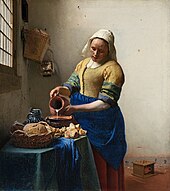Milkmaid

A milkmaid is a "girl who worried the milk and it also has for sale." According to the German dictionary (offering).
Milk maids or milk maids played a major role in history in the field of milk production and processing. Your task included a. Milking activities, making butter or selling milk and milk products on the milk market.
The term “dairy girl” is synonymous. This term probably applies more to the girls working in production.
The milkmaid's field of activity corresponds to that of the milkmaid and milkman.
Representations of milkmaids in art
There is a painting by the Dutch painter Jan Vermeer showing a milkmaid at work (45.45 cm × 40.6 cm, oil on canvas, painted 1658–1660, now in the Rijksmuseum in Amsterdam ).
Francisco de Goya painted a milkmaid from Bordeaux in 1827 (oil on canvas, 86 cm × 74 cm, Prado , Madrid ).
By Aelbert Jacobsz. Cuyp 's painting A View of Dordrecht with a Milkmaid and Four Cows dates from around 1650 (oil on canvas, 157.5 cm × 197 cm, National Gallery , London ). In the Getty Museum in Los Angeles there is a drawing by the same artist showing a milkmaid (made around 1640–1650).
The painting Laitière (oil on canvas, 38.74 cm × 55.25 cm, Rehs Galleries, Inc., New York) was created by the French painter Julien Dupré . There are other paintings by him depicting milkmaids.
Also known are some depictions of milkmaids by the French painter Jean-François Millet .
In Saint-Lô there is a bronze statue by Arthur Le Duc from 1888 showing a milkmaid from Normandy .
In Cologne's Poll district there is a milkmaid statue in memory of the Poller milkmaids who brought milk from Poll to Cologne until the middle of the 20th century. Until about 1900 by barge across the Rhine, then with carts pulled by dogs, donkeys, mules or horses. In Cologne, the milk was mostly sold by offering in fixed areas but also by home deliveries or at markets.
In the Catherine Park at the Catherine Palace in Tsarskoye Selo near Saint Petersburg , a milkmaid statue sits on a stone. The milkmaid with a broken jug comes from the workshop of the Russian sculptor Pawel Petrovich Sokolov . Two casts of the original created in 1807/10 are now in the parks of Schloss Britz and Schloss Glienicke in Berlin.
Other connections
The Metropolitan Museum in New York dedicated an exhibition in 2010 to the topos on which Vermeer's milkmaid was based, emphasizing the tangible, erotic undertones of the motif.
In Indian mythology there are the Gopis who, as milkmaids and cowherdesses, are the worshipers of the youthful god Krishna . Gopis are sung about in the poetry collection Sursagar by the poet Surdas from the 16th century and subsequently in the dance theater form Ras lila in connection with the story of the young Krishna as a butter thief.
In Normandy , the milkmaid (laitière) is an important cultural symbol.
See also
literature
- Dairy girls: ways of working and living in the 19th century. Schleswig 1991, DNB 920009379 .
Web links
Individual evidence
- ↑ Milkmaid. In: Jacob Grimm , Wilhelm Grimm (Hrsg.): German dictionary . tape 6 : Grain - Ordinary - (IV, 1st section, part 3). S. Hirzel, Leipzig 1911, Sp. 2195 ( woerterbuchnetz.de ).
- ↑ Entry on the milkmaid monument on the Efeuplatz in Poll in the database " KuLaDig " of the Rhineland Regional Association , accessed on August 1, 2017.
- ↑ Where the Pope meets the milkmaids. In: koeln-magazin.info
- ↑ Metropolitan article with slideshow on the topos
- ↑ See John Stratton Hawley: Krishna, the Butter Thief. Princeton University Press, Princeton 1983


